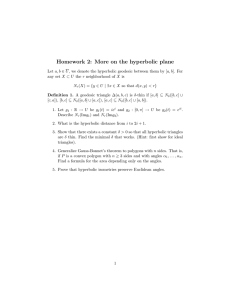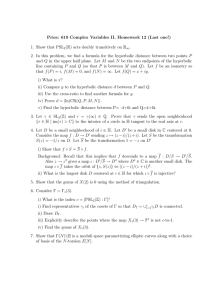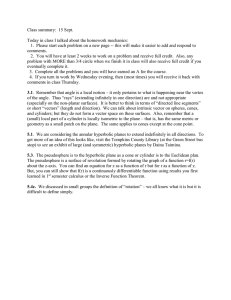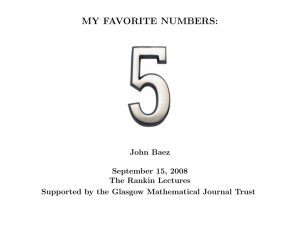SMALL COVERS OF THE DODECAHEDRON AND THE 120-CELL
advertisement
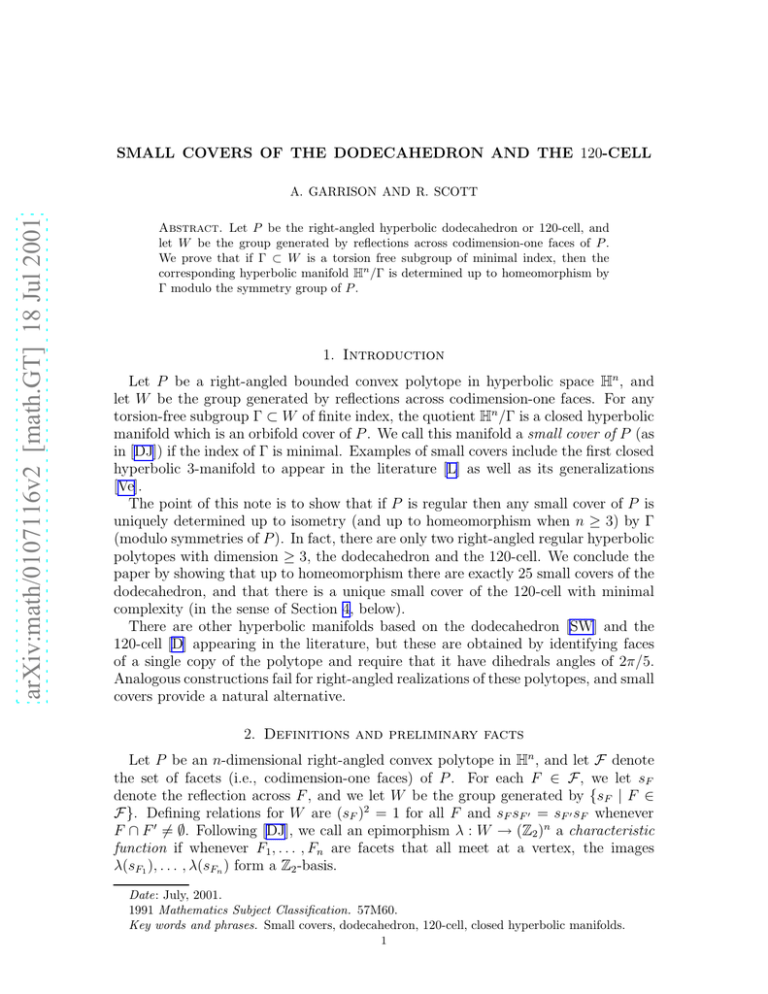
SMALL COVERS OF THE DODECAHEDRON AND THE 120-CELL
arXiv:math/0107116v2 [math.GT] 18 Jul 2001
A. GARRISON AND R. SCOTT
Abstract. Let P be the right-angled hyperbolic dodecahedron or 120-cell, and
let W be the group generated by reflections across codimension-one faces of P .
We prove that if Γ ⊂ W is a torsion free subgroup of minimal index, then the
corresponding hyperbolic manifold Hn /Γ is determined up to homeomorphism by
Γ modulo the symmetry group of P .
1. Introduction
Let P be a right-angled bounded convex polytope in hyperbolic space Hn , and
let W be the group generated by reflections across codimension-one faces. For any
torsion-free subgroup Γ ⊂ W of finite index, the quotient Hn /Γ is a closed hyperbolic
manifold which is an orbifold cover of P . We call this manifold a small cover of P (as
in [DJ]) if the index of Γ is minimal. Examples of small covers include the first closed
hyperbolic 3-manifold to appear in the literature [L] as well as its generalizations
[Ve].
The point of this note is to show that if P is regular then any small cover of P is
uniquely determined up to isometry (and up to homeomorphism when n ≥ 3) by Γ
(modulo symmetries of P ). In fact, there are only two right-angled regular hyperbolic
polytopes with dimension ≥ 3, the dodecahedron and the 120-cell. We conclude the
paper by showing that up to homeomorphism there are exactly 25 small covers of the
dodecahedron, and that there is a unique small cover of the 120-cell with minimal
complexity (in the sense of Section 4, below).
There are other hyperbolic manifolds based on the dodecahedron [SW] and the
120-cell [D] appearing in the literature, but these are obtained by identifying faces
of a single copy of the polytope and require that it have dihedrals angles of 2π/5.
Analogous constructions fail for right-angled realizations of these polytopes, and small
covers provide a natural alternative.
2. Definitions and preliminary facts
Let P be an n-dimensional right-angled convex polytope in Hn , and let F denote
the set of facets (i.e., codimension-one faces) of P . For each F ∈ F , we let sF
denote the reflection across F , and we let W be the group generated by {sF | F ∈
F }. Defining relations for W are (sF )2 = 1 for all F and sF sF ′ = sF ′ sF whenever
F ∩ F ′ 6= ∅. Following [DJ], we call an epimorphism λ : W → (Z2 )n a characteristic
function if whenever F1 , . . . , Fn are facets that all meet at a vertex, the images
λ(sF1 ), . . . , λ(sFn ) form a Z2 -basis.
Date: July, 2001.
1991 Mathematics Subject Classification. 57M60.
Key words and phrases. Small covers, dodecahedron, 120-cell, closed hyperbolic manifolds.
1
2
A. GARRISON AND R. SCOTT
Proposition 2.1. If Γ is a torsion free subgroup of W , then its index is ≥ 2n . If the
index is equal to 2n , then Γ is normal and is the kernel of a characteristic function
λ : W → (Z2 )n .
Proof. We consider the reflection tiling of Hn corresponding to P and W . If C is
a codimension-k cell in this tiling, then there are exactly 2k maximal cells containing
C, and the stabilizer Stab(C) is isomorphic to (Z2 )k . If Γ is torsion-free, then the
natural map Stab(C) → W/Γ must be injective; hence, the index of Γ is at least 2n .
If the index is equal to 2n , then for any 0-cell v, the map φ : Stab(v) → W/Γ is a
bijection. We let λ be the composition
−1
φ
W −→ W/Γ −→ Stab(v) ∼
= (Z2 )n .
It is not a priori a homomorphism, but since the defining relations for W also hold
for the images {λ(sF ) | F ∈ F }, there is an induced epimorphism µ : W → Stab(v)
defined by µ(sF ) = λ(sF ), for all F ∈ F . It is clear that if λ and µ agree on all
but one element in the stabilizer of a cell, then they must also agree on the entire
stabilizer. Using this fact and the fact that λ and µ agree on the generators of W ,
it follows that λ = µ. In particular, λ is an epimorphism and Γ is its kernel. That
λ is a characteristic function follows from the fact that Stab(v) → W/Γ must be a
bijection for every v.
Definition 2.2. Let λ : W → (Z2 )n be a characteristic function, and let Γλ = ker(λ).
The small cover of P associated to λ is the closed hyperbolic manifold Mλ = Hn /Γλ .
Small covers are functorial in the following sense.
Proposition 2.3. Let Mλ be a small cover of P . For any face F of P , let HF ⊂ Hn
be the hyperbolic subspace spanned by F and let MF be the image of HF in Mλ (that
is, MF = HF / (Γλ ∩ Stab(HF ))). Then MF is a totally geodesic submanifold which
is itself a small cover of the face F .
Proof. The stabilizer Stab(F ) ⊂ W fixes HF pointwise and is mapped isomorphically by λ onto a codimension-k subspace VF ⊂ (Z2 )n (where k = dim(F )). Each
facet of F can be expressed uniquely as the intersection F ′ ∩ F where F ′ is a facet of
P that is orthogonal to F , and we let WF denote the subgroup of W generated by the
corresponding reflections sF ′ . The characteristic function λ induces a characteristic
function λ : WF → (Z2 )n /VF for the polytope F with kernel Γλ ∩Stab(HF ). It follows
that MF = Mλ .
Let A (= A(P )) denote the symmetry group of P , and let G = GLn (Z2 ). We say
that two small covers Mλ and Mµ are equivalent if λ = g ◦ µ ◦ a for some a ∈ A
and g ∈ G. Any small cover Mλ has a natural (totally geodesic) cell decomposition
induced by the tiling of Hn .
Proposition 2.4. Two small covers Mλ and Mµ are equivalent if and only if they
are isomorphic as cell complexes.
Proof. It is clear that equivalent small covers are isomorphic as cell complexes.
Conversely, suppose φ : Mλ → Mµ is an isomorphism of cell complexes. Then the lift
SMALL COVERS OF THE DODECAHEDRON AND THE 120-CELL
3
e µ φe−1 . Since
φe : Hn → Hn is an automorphism of the tiling of Hn such that Γλ = φΓ
the automorphism group of the tiling is a semi-direct product of W and A, there
exists an a ∈ A such that Γλ = wΓµ◦a w −1 for some element w ∈ W . It follows that
Γλ = Γµ◦a (they are both normal), hence λ = g ◦ µ ◦ a for some g ∈ G.
3. The main theorem
Let P be a right-angled hyperbolic polytope as above. P is regular if its symmetry
group acts transitively on the simplices in its barycentric subdivision. Any such
simplex must be a hyperbolic Coxeter simplex, and by examining the standard list of
these simplices (Bourbaki [B], p. 133) one can show that P must be either a polygon
with > 4 sides, the dodecahedron, or the (4-dimensional) 120-cell. An important
property of these regular polytopes is the following:
Lemma 3.1. Let P be a regular right-angled hyperbolic polytope, and let L be the
length of an edge in P . Then any path in P that connects non-adjacent facets has
length ≥ L with equality holding only if the connecting path is an edge of P .
Proof. Let α be a connecting path with endpoints lying on the (disjoint) facets F
and F ′ . Because P is regular, it has a “cubical” decomposition obtained by cutting
each edge with the orthogonal hyperplane through its midpoint (see Figure 1). We
F′
α
HE
B
D
E
F
Figure 1.
define two open neighborhoods B and D of the facet F as follows. B is the union of
the interiors of all cubes that intersect F , and D is the set of all points of P whose
distance to F is less than L/2. We claim that D ⊂ B. To see this, it suffices to note
that if E is an edge meeting F othogonally at a vertex and HE is the hyperplane
bisecting E, then D lies entirely on one side of HE (since the edge E, being a common
perpendicular to HE and F , realizes the shortest distance between the corresponding
hyperplanes). Similarly, if B ′ and D ′ are the corresponding neighborhoods of F ′ , we
have D ′ ⊂ B ′ . Since F and F ′ are not adjacent, B ∩ B ′ = ∅ and, hence, D ∩ D ′ = ∅.
This means
l(α) ≥ l(α ∩ D) + l(α ∩ D ′ ) ≥ L/2 + L/2 = L,
and since the edge E is the unique path of minimal length joining F to HE , the
equality l(α) = L is only possible if α is an edge of P .
4
A. GARRISON AND R. SCOTT
Remark 3.2. To see that the lemma can fail without the regularity hypothesis, let P
be any right-angled n-dimensional polytope and let E ⊂ P be a minimal length edge.
By gluing 2n−1 copies of P together around the edge E, one obtains a right-angled
polytope Q with E now being an interior connecting path that is as short as any edge
of Q.
We are now in a position to prove the main theorem. The argument is based on
the fact that an isometry must preserve the set of minimal length closed geodesics.
To simplify the exposition, we call a closed geodesic in a small cover an edge loop if
it is of the form ME (Proposition 2.3) for some edge E ⊂ P .
Theorem 3.3. Let P be an n-dimensional right-angled regular hyperbolic polytope.
Then two small covers of P are isometric if and only if they are equivalent.
Proof. First we show that if M is any small cover of P , then any closed geodesic
of minimal length must be an edge loop. Let α be a closed geodesic in M, and let
F be a codimension-one cell in M that intersects α transversely. Lifting α to the
universal cover Hn , we obtain a geodesic segment α
e that connects two lifts Fe and
Fe ′ of the cell F (see Figure 2). Let H and H ′ be the hyperplanes spanned by Fe
Fe
H
β
α
e
H′
Fe ′
Figure 2.
and Fe′ , respectively. Since H and H ′ are both mapped to the face F under the
projection Hn → Hn /W = P , they are hyperparallel, thus have a (unique) common
perpendicular β. Moreover, β must pass through at least two copies of the tile P . It
follows from Lemma 3.1 that the length of β is ≥ 2L with equality holding only if
β is the lift of an edge. Since the geodesic α
e is at least as long as β with equality
e the closed geodesic α will have minimal length only if it is an
holding only if α = β,
edge loop.
Now suppose φ : Mλ → Mµ is an isometry. Since φ takes minimal length closed
geodesics to minimal length closed goedesics, it must take edge loops to edge loops.
The 0-cells in a small cover can be characterized as the points where edge loops
intersect, thus φ must take 0-cells to 0-cells and, therefore, 1-cells to 1-cells. Since
any cell of dimension ≥ 2 in a small cover can be characterized as the convex hull of
its bounding 1-cells, the isometry φ must take cells to cells. Thus, by Proposition 2.4,
Mλ and Mµ are equivalent.
Mostow rigidity gives the following:
Corollary 3.4. If P is the dodecahedron or the 120-cell, then two small covers of P
are homeomorphic if and only if they are equivalent.
SMALL COVERS OF THE DODECAHEDRON AND THE 120-CELL
5
4. Small covers of the dodecahedron and 120-cell
In this section, we describe an algorithm for enumerating equivalence classes of
small covers for general P , and apply it to the dodecahedron and 120-cell. The
complexity of the algorithm becomes unfeasible for the 120-cell, so instead we apply
it to a restricted class of characteristic functions.
The algorithm. Let P be n-dimensional, and let F1 , . . . , Fd be any ordering of the
facets such that the first n facets F1 , . . . , Fn all meet at a vertex. Given any characteristic function λ : W → (Z2 )n , we let λi be the image λ(sFi ) of the fundamental
reflection across the ith facet. By definition a d-tuple λ = (λ1 , . . . , λd ) determines
a characteristic function if and only if the λi ’s corresponding to facets meeting at a
vertex form a basis for (Z2 )n . We call such a λ a labeling of P and each λi a label.
We say a labeling is normalized if the first n labels form the standard basis for (Z2 )n ,
and we let Λ(P ) denote the set of normalized labelings of P . The following algorithm
determines Λ(P ).
Algorithm 4.1. Let λ1 , . . . , λn be the standard basis for (Z2 )n , and let S be the set
(Z2 )n − {0} (with some fixed order).
1. Assume by induction that λ1 , . . . , λi have been chosen, and let Si+1 be the list
S with all elements of the following form removed: λi1 + . . . λik where that ij ≤ i
for 1 ≤ j ≤ k and Fi1 ∩ · · · ∩ Fik 6= ∅.
2. If Si+1 = ∅ we know that there are no (unrecorded) labelings that begin λ1 , . . . λi .
In this case, we back up until we find a nonempty Sl with l < i (and l as large
as possible). We let λl be the first element in Sl and go back to Step 1, using
l instead of i. If Si+1 6= ∅, we let λi+1 be the first element in the list Si+1 and
remove it from Si+1 . If i + 1 < d, we go back to Step 1, using i + 1 instead of i.
If i + 1 = d, we add the full labeling λ to Λ(P ) and repeat Step 2.
The group of symmetries A(P ) acts on Λ(P ), and the equivalence classes of small
covers are in bijection with A(P )-orbits. To determine these orbits, we choose a set
of generators for A(P ) and form the graph whose vertices are elements of Λ(P ) and
whose edges join any pair of vertices that differ by a generator of A(P ). One then
applies any standard graph algorithm to determine the connected components of this
graph.
The dodecahedron. Let P 3 be the regular dodecahedron. The symmetry group
A(P 3 ) is the Coxeter group with diagram H3 :
3
b
5
c
d
Using the algorithm, we obtain 2165 normalized labelings of P 3 . Forming the graph
on this set Λ(P 3) with respect to the standard generating set {b, c, d} for A(P 3 ),
we obtain 25 connected components. Representative labelings are given in Table 1.
To keep the data concise, we have used decimal equivalents for (Z2 )3 (for example,
(1, 0, 0) ↔ 4 and (1, 1, 0) ↔ 6). The ordering we use for the facets is shown in
Figure 3.
6
A. GARRISON AND R. SCOTT
10
4
8
6
1
2
3
5
11
7
12
9
Figure 3.
Table 1. Small covers of the dodecahedron
λ = (λ1 , . . . , λ12 )
(1, 2, 4, 4, 2, 6, 1, 7, 7, 1, 3, 5)
(1, 2, 4, 4, 2, 6, 3, 5, 5, 7, 3, 1)
(1, 2, 4, 4, 2, 7, 1, 7, 7, 1, 3, 5)
(1, 2, 4, 4, 2, 7, 3, 5, 5, 2, 6, 1)
(1, 2, 4, 4, 2, 7, 3, 7, 5, 2, 6, 1)
(1, 2, 4, 4, 2, 7, 3, 7, 5, 5, 6, 1)
(1, 2, 4, 4, 2, 7, 7, 1, 5, 6, 3, 4)
(1, 2, 4, 4, 2, 7, 7, 3, 5, 5, 6, 1)
(1, 2, 4, 4, 3, 6, 3, 7, 5, 5, 2, 1)
(1, 2, 4, 4, 3, 6, 5, 3, 6, 5, 2, 1)
(1, 2, 4, 4, 3, 6, 7, 3, 5, 1, 2, 6)
(1, 2, 4, 4, 3, 7, 7, 3, 2, 5, 6, 1)
(1, 2, 4, 5, 3, 7, 7, 3, 5, 4, 2, 1)
Aλ
1
1
1
1
1
1
1
1
Z2
S3
Z2
1
(Z2 × Z2 ) ⋉ Z6
λ = (λ1 , . . . , λ12 )
(1, 2, 4, 4, 2, 6, 3, 5, 5, 3, 1, 7)
(1, 2, 4, 4, 2, 6, 7, 1, 1, 3, 7, 5)
(1, 2, 4, 4, 2, 7, 1, 7, 7, 1, 4, 2)
(1, 2, 4, 4, 2, 7, 3, 5, 5, 6, 4, 7)
(1, 2, 4, 4, 2, 7, 3, 7, 5, 5, 3, 1)
(1, 2, 4, 4, 2, 7, 7, 1, 1, 2, 6, 5)
(1, 2, 4, 4, 2, 7, 7, 3, 5, 5, 3, 1)
(1, 2, 4, 4, 3, 6, 3, 5, 5, 7, 2, 1)
(1, 2, 4, 4, 3, 6, 3, 7, 6, 5, 2, 1)
(1, 2, 4, 4, 3, 6, 7, 3, 2, 5, 7, 1)
(1, 2, 4, 4, 3, 6, 7, 3, 5, 5, 2, 1)
(1, 2, 4, 4, 3, 7, 7, 3, 5, 6, 2, 1)
Aλ
1
1
(Z2 × Z2 ) ⋉ Z3
1
Z2
Z2
Z2 × Z2
1
1
Z2
Z2
Z2
Also included in the table is the stabilizer subgroup Aλ ⊂ A(P 3 ) for the given
labeling λ. This subgroup acts via isometries on the corresponding small cover Mλ
as does the group W/Γλ = (Z2 )3 . It follows from Theorem 3.3 that Mλ admits no
further symmetries. In other words, the isometry group of Mλ is the semi-direct
product of Aλ and (Z2 )3 . In particular, the small cover on the bottom left has the
largest symmetry group (with order 192).
The 120-cell. Let P 4 be the 120-cell. It has 120 dodecahedral facets, and the
symmetry group A(P 4 ) is the Coxeter group with diagram H4 :
3
a
3
b
5
c
d
In theory, our algorithm can be used to search for all possible labelings of P 4 with
labels in the set (Z2 )4 −{0}, but the running time is too large to make the computation
feasible. It is not hard to show that a labeling of P 4 must have at least 5 labels, and
that if it has exactly 5, they must be (modulo G) 1, 2, 4, 8, 15 (decimal equivalents
again). Applying Algorithm 4.1 using S = (1, 2, 4, 8, 15) (instead of S = (Z2 )n −{0}),
SMALL COVERS OF THE DODECAHEDRON AND THE 120-CELL
7
the search is effective and returns exactly 10 labelings. Another computation shows
that the stabilizer of one of these labelings has index 10; hence, all of these labelings
are equivalent. A representative labeling λ is given in Table 2.
It follows from Theorem 3.3 that up to homeomorphism Mλ is the unique small
cover that uses only 5 labels, and that no small cover using more than 5 labels is
homeomorphic to Mλ . Since A(P 4 ) has order 14, 400, the isometry group of Mλ has
order 16 × 1, 440 = 23, 040.
References
[B] N. Bourbaki. Groupes et algèbres de Lie, Chapters 4-6. Masson, Paris, 1981.
[D] M. Davis. A hyperbolic 4-manifold. Proc. Amer. Math. Soc. 93 (1985), no. 2, 325–328.
[DJ] M. Davis and T. Januszkiewicz. Convex polytopes, Coxeter orbifolds and torus actions. Duke
Math. J. 62 (1991), no. 2, 417–451.
[L] F. Löbell. Beispiele geschlossener dreidimensionaler Clifford-Kleinische Räume negativer
Krümmung. Ber. Sächs. Akad. Wiss. 83 (1931), 168–174.
[SW] J. Seifert and D. Weber. Die beiden Dodekaederräume, Math. Z. 37 (1933), 237–253.
[Ve] A. Yu. Vesnin. Three-dimensional hyperbolic manifolds of Löbell type. Siberian Math. J. 28
(1987), 50–53.
Department of Mathematics, Santa Clara University, Santa Clara, CA 95053
E-mail address: rscott@math.scu.edu
8
A. GARRISON AND R. SCOTT
Table 2. A labeling for the 120-cell using 5 labels. The facets are indexed by their barycenters, which were determined using the standard
4-dimensional geometric representation for A(P 4 ). This is the contragradient representation ([B], Chapter V, Section 4), so the generating
involutions are linear reflections across the coordinate hyperplanes and
are orthogonal with respect to the inverse of the Coxeter matrix of
type H4 . With respect to this representation the vector (2, 0, 0, 0) is
the barycenter of the first facet and the remaining barycenters are the
translates of this point under the action of A(P 4 ).
center of facet F
±(2, 0, 0, 0)
±(−2, 2, 0, 0)
±(0, −2, 2, 0)
√
±(0, 0, −2, 5 + 1)
√
√
±(0, 0, 5 + 1, −1 − 5)
√
√
±(0, 5 + 1, −1 − 5, 2)
√
±(0, 5 + 1, 0, −2)
√
√
±( 5 + 1, −1 − 5, 0, 2)
√
√ √
±( 5 + 1, −1 − 5, 5 + 1, −2)
√
√ √
±( 5 + 1, 0, −1 − 5, 5 + 1)
√
√
±( 5 + 1, 0, 2, −1 − 5)
√
±( 5 + 1, 2, −2, 0)
√
±( 5 + 3, −2, 0, 0)
√
±(−1 − 5, 0, 0, 2)
√
√
±(−1 − 5, 0, 5 + 1, −2)
√ √
√ √
±(−1 − 5, 5 + 1, −1 − 5, 5 + 1)
√ √
√
±(−1 − 5, 5 + 1, 2, −1 − 5)
√ √
±(−1 − 5, 5 + 3, −2, 0)
√ √
±(−3 − 5, 5 + 1, 0, 0)
√
√
±(0, −1 − 5, 0, 5 + 1)
√ √
√
±(0, −1 − 5, 5 + 3, −1 − 5)
√ √
±(2, −3 − 5, 5 + 1, 0)
√ √
±(−2, −1 − 5, 5 + 1, 0)
√ √
±(0, 2, −3 − 5, 5 + 3)
√ √
±(2, −2, −1 − 5, 5 + 3)
√ √
±(−2, 0, −1 − 5, 5 + 3)
√
√
±(0, 2, 5 + 1, −3 − 5)
√
√
±(2, −2, 5 + 3, −3 − 5)
√
√
±(−2, 0, 5 + 3, −3 − 5)
√
√
±(0, 5 + 3, −1 − 5, 0)
λ(F )
1
2
4
8
8
4
15
2
15
15
2
8
4
1
15
15
4
1
8
15
1
8
2
2
1
4
1
4
2
2
center
of facet
F
√
√ √
5 + 1, −3 − 5, 5 + 1)
√
√ √
±(−2, 5 + 3, −3 − 5, 5 + 1)
√
√
±(2, 5 + 1, 0, −1 − 5)
√
√
±(−2, 5 + 3, 0, −1 − 5)
√
√
±( 5 + 3, −3 − 5, 2, 0)
√
√
√
±( 5 + 3, −1 − 5, −2, 5 + 1)
√
√
√
±( 5 + 1, −3 − 5, 0, 5 + 1)
√
√ √
√
±( 5 + 3, −1 − 5, 5 + 1, −1 − 5)
√
√ √
√
±( 5 + 1, −3 − 5, 5 + 3, −1 − 5)
√
√
±( 5 + 3, 0, −1 − 5, 2)
√
√ √
±( 5 + 1, 0, −3 − 5, 5 + 3)
√
±( 5 + 3, 0, 0, −2)
√
√
√
±( 5 + 1, 0, 5 + 1, −3 − 5)
√
√
√
±( 5 + 1, 5 + 1, −1 − 5, 0)
√
√
±(2 5 + 2, −1 − 5, 0, 0)
√
±(−3 − 5, 0, 2, 0)
√
√
±(−3 − 5, 2, −2, 5 + 1)
√
√
±(−1 − 5, −2, 0, 5 + 1)
√
√
√
±(−3 − 5, 2, 5 + 1, −1 − 5)
√
√
√
±(−1 − 5, −2, 5 + 3, −1 − 5)
√ √
√
±(−3 − 5, 5 + 3, −1 − 5, 2)
√ √
√ √
±(−1 − 5, 5 + 1, −3 − 5, 5 + 3)
√ √
±(−3 − 5, 5 + 3, 0, −2)
√ √
√
√
±(−1 − 5, 5 + 1, 5 + 1, −3 − 5)
√ √
√
±(−1 − 5, 2 5 + 2, −1 − 5, 0)
√
±(0, −3 − 5, 2, 2)
√
√
±(0, −1 − 5, −2, 5 + 3)
√ √
±(0, −3 − 5, 5 + 3, −2)
√ √
√
±(0, −1 − 5, 2 5 + 2, −3 − 5)
√ √
±(0, 0, −3 − 5, 2 5 + 2)
±(2,
λ(F )
1
8
4
8
1
8
4
8
2
2
4
1
15
15
15
4
2
8
1
8
4
1
2
15
15
1
2
4
15
8
